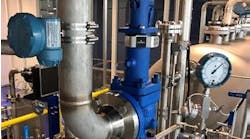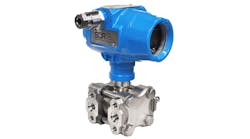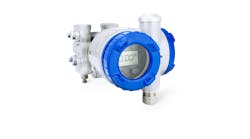During a presentation entitled "Gas Pressure Control: Why a Working Monitor Regulator System?" at the Emerson Global User Exchange this week, Michael Calaway, business development manager at Emerson Process Management, together with Ryan Baker, Fisher Valve and Regulator account manager from local business partner Puffer-Sweiven, discussed two redundant regulator configuration options as well as an application example at Dow Freeport.
Fuel gas pressure control
A typical fuel gas pressure control application is a fuel gas header that might sit on the fence line of the facility or on the main line entering a large processing unit. The fuel gas header pressure regulator is typically pilot operated, providing more accurate pressure control than a standard regulator. It also provides quick response to demand changes, attenuates noise and provides a high degree of reliability.
"Varying gas demands caused high fluctuations in the pressure. It was a mess." Puffer-Sweiven's Ryan Baker discussed how a redundant, working monitor regulator configuration that has helped improve fuel gas pressure control at Dow Freeport.
To help ensure a longer life and improved reliability in this typically single regulator application, a dual regulator, "monitor" system can be used. "The monitor set-up is two regulators in series with just a slight difference in regulator pressure setpoint. If one fails open, the other picks up and continues to operate."Further, monitoring systems come in two configurations called "open" and "working." The open monitor set-up is so-named because the first of the regulators in series remains wide open until it's called upon to act upon the failure of the second. Both regulators sense the same downstream pressure. If the downstream regulator is set to 10 psi and the upstream one to 15 psi, the upstream monitor regulator remains wide open during normal operation and the downstream regulator does all the heavy lifting.
One disadvantage of this configuration is that since the monitor regulator remains open, "we don't know if the first regulator is prepared to respond," Calaway said. "The working monitor set-up addresses this disadvantage by adding a second pilot and controlling to an intermediate pressure between the two regulators. During normal operations, then, the two regulators share the load. If either regulator fails, pressure control is maintained; only the intermediate pressure changes, alerting operators to the malfunction. "The smaller pressure step across each regulator can also help with reliability and noise reduction," Calaway added. "These advantages were very important to the situation at Dow."
Dow chose a working monitor regulator set-up as the new best practice to replace existing split-range control valves. "Dow had a split-range control valve with two fuel pressure regulators in series that had slow loop response time, high flow instability and a low degree of maintainability," explained Puffer-Sweiven's Baker. "Varying gas demands caused high fluctuations in the pressure. It was a mess."
"The new working monitor design allowed the elimination of relief valves and added desired redundancy," said Baker. Further, the solution resulted in a compact final installation using common 3-in. valves. "Response to a flare event was almost instantaneous, with little to no pressure droop, overshoot or cycling." There have been no issues since installation about a year ago. With these advantages and low maintenance, Dow is looking into other applications for this working monitor regulating system, Baker said.
Latest from Pressure

Leaders relevant to this article:






